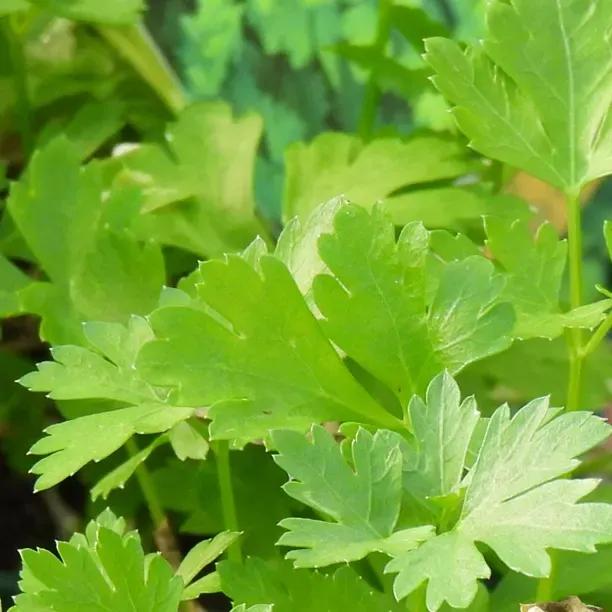Flat Leaved Parsley Plants
The details
Petroselinum crispum
Pot Grown Herbs- Height: 45-60 cm
- Spread: 25 cm
- Colour: green with white flowers
- Flowers: summer
- Uses: culinary, herb garden
- Spacing: 15 cm
- Scent/Taste: Minerally
- Habit: upright
- Life: hardy biennial
- One of the four fines herbes
Recommended extras
Description
Petroselinum crispum French
Flat Leaved Parsley is an elegant wafting thing with large, dark green toothed but yes, flat, leaves that grow to quite a height. The flowers are smaller than the Curly variety but are also a creamy white. However, you are not growing it for its flowers; the leaves are where it's at, and you should continue to harvest these over the summer months. Ideally you cut the plant down at the first hint of flowers so that it can regenerate to give you handfuls more foliage. An important member of our range of herbs and vegetables.
The flavour of flat leaf parsley is a little bit stronger - but more rounded - than curly parsley and so it is treasured by chefs for its ability to focus the flavours of other ingredients and to add its own nutritional heft and taste - think tabbouleh, baba ghanoush or just large quantities of the stuff in salad used like any other vegetable. Wilted with garlic on toast with a poached egg or as the main ingredient in a soup, parsley rarely fails to please.
A parsley for cooks
Although flat leaf parsley definitely has the edge over the curly variety for most in the kitchen, it is less decorative and so is mainly grown as a crucial adjunct to a herb garden. But its dark leaves provide an attractive contrast to other herbs like Golden Queen thyme or the purple flowers of oregano.
Such a large expanse of leaves, and a long tap root, mean that it is a thirsty plant, so you need to water it frequently when it is hot and plant it somewhere out of direct sunlight - an east or west facing aspect suits best - or in a raised bed somewhere close to the kitchen for easy snipping access. Flat leaf parsley will do well in pots or even on a the kitchen window sill so long as you remember to water it frequently and feed it occasionally. Its long tap root also needs space, so give it a generous pot to fill and do not overcrowd it with too many plants. The leaves can be frozen and don't forget to use the defoliated stalks to add flavour to soups and stews.
Flat Leaved Parsley Features
- Height: 45-60 cm
- Spread: 25 cm
- Colour: green with small, creamy white flowers
- Flowers: summer
- Uses: culinary - raw and cooked, herb garden
- Spacing: 15 cm
- Scent/Taste: Minerally - stronger than curly parsley
- Habit: upright
- Life: hardy biennial
Did You Know?
The Greeks had mixed emotions about parsley because it was associated with Archemorus the herald of death and so was strewn around Greek tombs. Hercules used to use parsley for his victory garlands, and when this tradition continued and parsley garlands were given to other victors at Greek Games, the victors chose to give the garlands to their horses to eat rather than eat it themselves! At the other end of the spectrum, if you make a tea out of parsley seeds and pour it over your head and then wrap your head in a towel for an hour, it will kill head lice.
It is one of les fines herbes, and thus a cornerstone of French cuisine (the others are chervil, chives, and tarragon).


